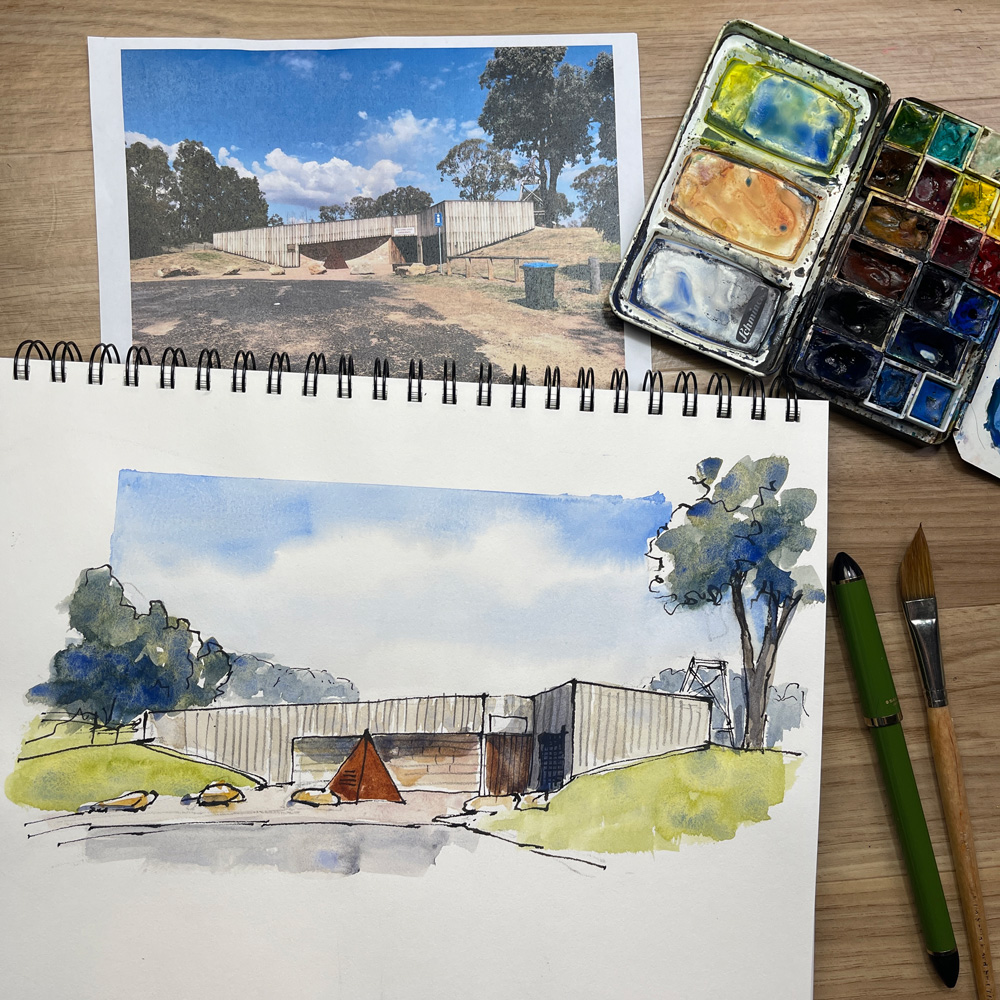
A lot of sketchers think that they have to draw and paint everything in a scene exactly as they see it. But in order to make a sketch that reads well and effectively tells a story we normally have to do some design work and make some slight adjustments.
In my public livestream this week I explained how I made a number of changes while sketching from this photo of a museum in Gulgong (a lovely historic town in NSW that I visited during last year’s big road trip). These adjustments involved deleting, relocating, slightly resizing adjusting the hue, value and saturation.
I made some kind of adjustment to the following parts of this scene:
- garbage bin
- fence
- sign
- pyramid
- rocks
- curved shadow on the building
- grass
- background trees
- tree on the right behind the building
- timber cladding to the building
- the sky.
Hmm, listing them all out like this makes me feel as if I changed everything! But they were mostly minor adjustments to help simplify the scene for the sake of a live demo. The replay of this demo can be watched here.
This idea of designing a sketch and moving things around is a big topic in my Watercolour On Location course. And it’s something that I remember discussing a lot with the group last time we went through the course in 2022. We always have to balance how much we adjust with our desire to be ‘truthful’ to a scene and personal preference comes into it as well.
Note: There is a difference between intentionally making changes in order to tell our story better and having to adjust parts of the sketch to recover from a mistake in our observational skills. 🙂
Our interpretation of a scene is one of the most important aspects of sketching (and any painting or drawing) and yet it doesn’t get discussed that much. Talking about materials (what pen, what brush, what paint colour, what sketchbook etc) always seems to dominate any sketching discussion. This is why I’m so excited to be going through Watercolour On Location again with a group so that I can share lots of thoughts and practical advice on one of my favourite topics!
I’m guessing that you all know by now… but if somehow you missed it… The Live Version of Watercolour On Location starts next week on Wednesday 28 September 2022. We’ll be working through the lessons together as a group for three months and I’ll be hosting weekly bonus livestreams at the end of each lesson week to discuss the main themes, do more demos, review selected work from the classroom and answer everyone’s questions. Find out more here.
I would love to hear from you …
How much adjusting of a scene do you typically do when you are out sketching on location? Or is this a new concept?
(If you are reading this via email, please click on the article title link below and add a comment on my blog. Thanks!)







4 Comments
Since I am doing a continuous line challenge at the moment, I am not editing much. I can’t definitely see the benefit of editing, but in urban sketching how much latitude in editing does one have?
Hi Bobbie – even when doing continuous lines you have the chance to edit out certainly things (or edges). As for your question there is no easy answer but minor adjustments (eg. moving, resizing) and leaving things out is fine. adding things that don’t exist is more of an issue IMHO.
Thank you for providing a photo of the scene. It really helps others to see what your “leave out” and “include” choices were. I have a hard time giving myself permission for “leaving out”. Examples such as yours show the importance of focusing on the point of the sketch and eliminating extraneous details that don’t really contribute to that focus.
Thanks John – more photos in the next blogpost as well! And yes sketching is not about copying a scene exactly – a focus is all important
NEWSLETTER
Subscribe for first notification of workshop + online classes and more.